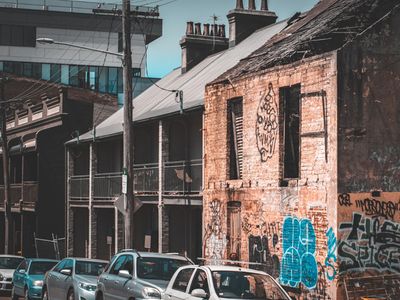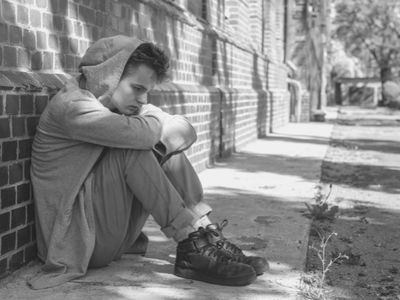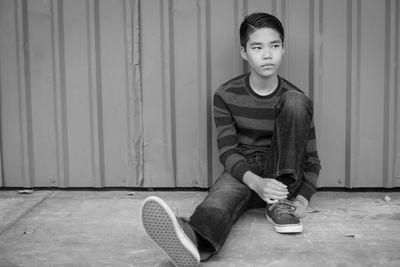About Youth Homelessness
Home / Our Work / About Youth Homelessness
It’s not all sleeping rough
It’s common for people to think that all people experiencing homelessness sleep on the streets. But rough sleeping is only a small part of the problem of homelessness. Homelessness is about not having a home, which means not having a sense of security, stability, privacy, safety and the ability to control your living space.
Couch surfing
When a young person becomes homeless (either because they have to leave home or their whole family becomes homeless) they might stay temporarily with friends, family or people they don’t know very well. This is often called ‘couch surfing’, which might sound harmless but, in reality, means you don’t have your own space, privacy or security, it's unstable, and it can also be dangerous.
Most young people who are homeless are living in a ‘severely overcrowded’ house. Often, that means having to crash on the couch or the floor or share a bedroom. A severely overcrowded house is one that needs four or more extra bedrooms to properly house everyone living there.
Other places homeless people stay
Young people’s alternatives to couch surfing are emergency accommodation in refuges, government-funded transitional housing, boarding houses, hostels or motels. Some young people who become homeless might have to sleep rough in squats, cars or public spaces for a period of time.
Snapshot of youth homelessness

Homelessness is more than houselessness
Homelessness does not just mean sleeping rough on the streets. Three categories of homelessness were adopted by the Commonwealth Advisory Committe on Homelessness in 2001 and are widely used by the homelessness sector in Australia.
Primary homelessness includes all people without a ‘roof over their head’. This means people who are living on the streets, sleeping in parks, squatting in derelict buildings, or using cars or trains as temporary shelter.
Secondary homelessness includes people who frequently move from one type of shelter to another. This includes people living in homelessness services or hostels, people staying with other households who have no home of their own, and people staying in boarding houses for 12 weeks or less.
Tertiary homelessness refers to people who live in boarding houses on a medium- to long-term basis (more than 13 weeks), who live in accommodation that does not have ‘self-contained facilities’ (for example, they don't have their own bathroom or kitchen), and who don’t have the security provided by a lease. These people are homeless because their accommodation does not have the characteristics identified in the minimum community standard for housing.

Youth homelessness is unseen
We often hear the reference to ‘street kids’ but in fact most young people experiencing homelessness are invisible to us. This generally means they are temporarily staying with friends, relatives, family and sometimes with complete strangers. These young people will often be sleeping on couches or on the floors of these people’s houses until they outstay their welcome and move on to the next place – hence the term 'couch surfing'.
Young people experiencing homelessness do not need rough sleeping initiatives alone. To prevent homelessness they need effective access to accommodation, family reconciliation services, community support and education programs.
Around 28,200 children and young people aged 12–24 years were experiencing homelessness on Census night 2021 across Australia, making up almost a quarter of the total homeless population that night. This comprises 11,302 children and young people aged 12–18 years; and 16,902 young adults aged 19–24 years.
In the 2021 Census, children and young people (12–24 years) made up 30% of total homeless persons living in ‘severely’ crowded dwellings, 27% of persons in supported accommodation for the homeless, and 16% of persons staying temporarily in other households. However, Census estimates may under-represent the extent of youth homelessness, as some young couch surfers may report their usual address as the household in which they are staying on Census night (ABS 2023).
Nationally, in 2022–23 over 38,300 15–24 year olds presented alone to specialist homelessness services. The main reasons why these young people needed help was due to:
19% – Housing crisis
15% – Domestic and family violence
12% – Relationship and/or family breakdown.
Around half (48%) had a current mental health issue.
Specific strategies to address child and youth homelessness are critical to the overall reduction of homelessness in Australia.

Homelessness can affect any young person
There is a variety of reasons why children and young people become homeless that are often outside their control. The general view is that young people experiencing homelessness are run-aways and could really return home if they wanted to. In reality, many young people become homeless due to family breakdown, family violence and child abuse.
In 2022–2023, 24% of young people experiencing homelessness at first presentation identified interpersonal relationship problems, including family violence and relationship/family breakdown, as the primary reason for becoming homeless. The next most common reasons were: experiencing a housing crisis (23%) and living in inadequate accommodation such as overcrowded housing (15%).
Many young people find it difficult to be approved for leases due to the current housing crisis, the high demand on rental properties and discrimination against young people. Issues around overcrowding and the cost of housing also cause young people to become homeless.
Homelessness affects all groups of people and we know that young people who are Indigenous, are from a single or blended family, have been homeless as a child, are LGBTQI+, or have been in statutory care, are at greater risk of homelessness.
The community needs to stop judging young people experiencing homelessness as delinquent, and create opportunities for young people to not become homeless or to access long-term housing.